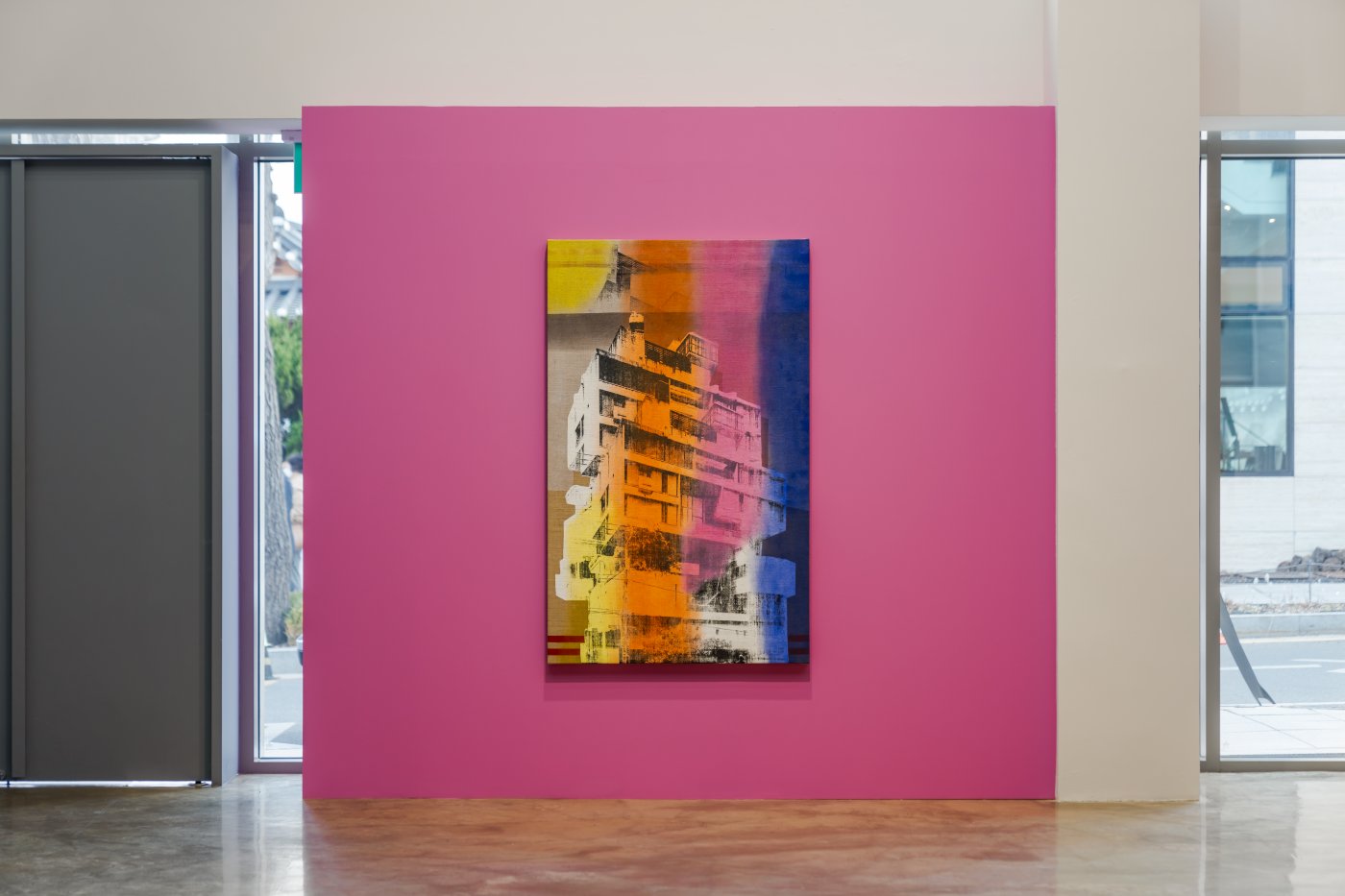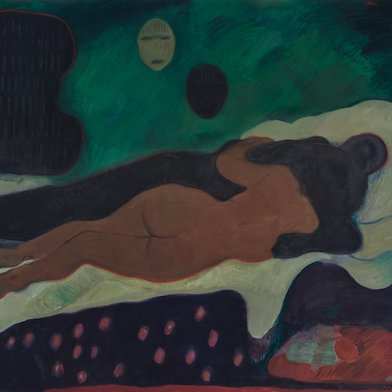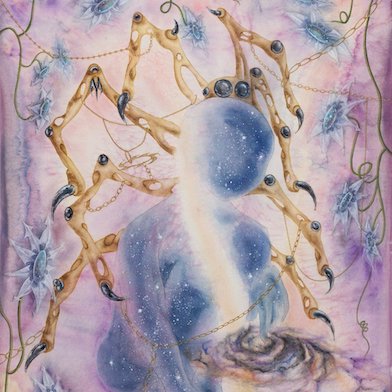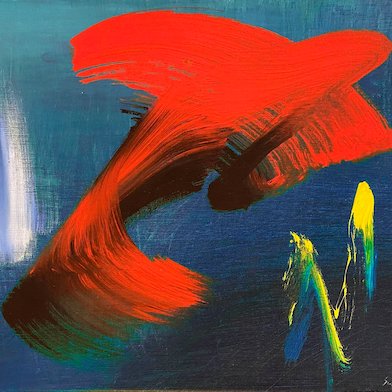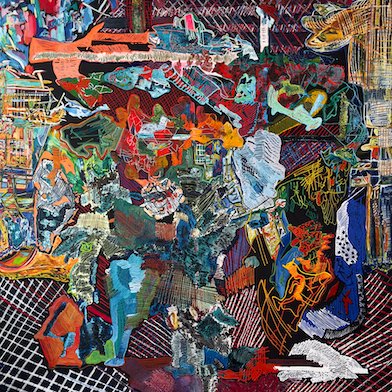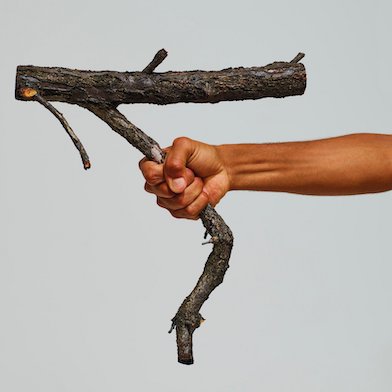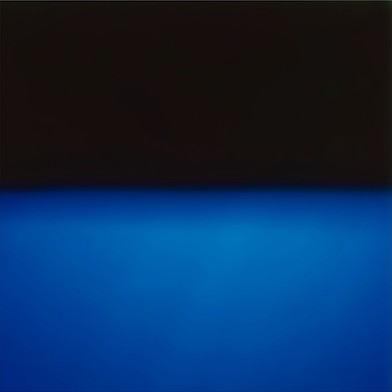Open: Tue-Sun 10am-6pm
Visit
Shezad Dawood: Integrations
Barakat Contemporary, Seoul
Wed 15 Mar 2023 to Sun 23 Apr 2023
58-4 Samcheong-ro, Jongno-gu, Shezad Dawood: Integrations
Tue-Sun 10am-6pm
Artist: Shezad Dawood
The surfaces of intense fluorescent colors geometrically divide the space, then reintegrate the space back into an axis of sensations. From the abstract backdrop into which the color planes seep, protrude figurative architectural forms; and together they fragment and unify the painting surface irregularly. The way the layers are captured resembles a camera shutter adjusting automatically to the depth of field. Cutting, dividing, then assembling and unifying again, the series of visual processes of the composition expedites synesthesia and superposes a sense of motion on a still image. Integrations, Shezad Dawood’s (b. 1974) second exhibition at Barakat Contemporary, features a sensorial symphony through which the overture of colors and the variations of segmentation visualize the epochal challenges that everyone who utilizes, enjoys, or consumes architecture confronts.
Living in our current age of unpredictability affords artists the privilege of transcending categories, or moving fluidly across the boundaries of multimedia. Shezad Dawood is at the forefront of this movement. His first exhibition at Barakat Contemporary, Leviathan: on Sunspots and Whales (2018), was a hybrid project, spanning painting, sculpture, installation and film. In close collaboration with experts from various academic fields, Dawood addressed major contemporary issues: from climate change to marine welfare, migrants and refugees, democracy, and mental health. In embracing the hybridization of our time, Dawood's work eschews reductive categories, instead demonstrating that art should not be bound to, or operate exclusively within its own field.
This approach is further expanded in Integrations. His latest solo exhibition is a study of 20th-century modernist architecture, revealing the geological, environmental, social and economic histories indexed by buildings' vernacular, while also highlighting their architects' contribution to the urban landscape, bridging past, present and future.
When viewed as a public art form, architecture, which encompasses both pedagogy and engineering, is where education, art, and daily life converge. Born to a Pakistani mother and Indian father and raised in London, his multicultural background naturally led him to have a keen eye for the syntheses materialized as architecture. Dawood’s Doha Modern Playground (2022), a public art installation commissioned by Qatar Museums, transforms the modern buildings of the region into play objects; the work functions as a playground for children, a medium that reflects architectural history, and a public museum that invites art into daily life. The artist’s continuous investigation of architecture pertaining to social and historical identities extends to Integrations.
The exhibition takes its title from Les Intégrations, an artistic project in support of public infrastructure launched by Abdeslam Faraoui and Patrice de Mazières in the 1960s. By collaborating with Moroccan artists and adopting traditional arts and crafts, Les Intégrations sought to bring down the barrier between art and popular culture, promote art’s involvement in daily life, and renew Morocco’s cities and society. These ideals, and a desire to recover something of this lost optimism, inspired Dawood's new series of works, premiered at Barakat Contemporary.
The works encapsulate various modernist buildings from the Global South including India, Cambodia, Iran, Egypt, Ghana, Mexico, and Japan and reconstructs them into images on jute, after repeatedly dividing them into color fields, and re- combining them into forms. Each work is titled as per the depicted building’s architect. When Louis Met Ahmed (2023) is Dawood’s transcription of the Indian Institute of Management, Ahmedabad (IIMA) building; it is named after its architect, Louis Kahn – one of the greatest masters in modernist architecture – and the city where it stands. The IIMA building incorporates India’s traditional style into an innovative modernist construction, and is considered a magnum opus of Kahn’s. Meanwhile, it is also the subject of ongoing controversy: multiple attempts to demolish and reconstruct a major part of the campus have been halted due to strong opinions opposing the destruction of its legacy.
The questions around the continuity of coexistence – for example when a work of art once fully functioning in our daily lives is considered obsolete for the sake of convenience, but is left intact for its aesthetic value – recur in Hassan (2023). The project visits Egypt’s modernist architect Hassan Fathy’s attempt at an “architecture for the poor” in New Gourna Village; it sought to build houses based on local traditions and resuscitate the community’s economic independence. Dawood takes notice of how the plan was discontinued due to practical as well as administrative issues, but a part of it is still preserved as a meaningful architectural case study. As the artist recalls the narratives of contestation permeated within the polychromatic forms, art and everyday life unravel upon a single thread.
Returning to the interlinked color fields, we can see how the efforts to embed art into the space of the everyday lead to other variations and form expanded images. It is a vertigo-like experience; a still image is put in motion in a world where the vanishing point is constantly shifting. Nevertheless, one does not get lost because through the expanded colors, one endlessly embraces an artwork in space, architecture within an artwork, a daily life reflected in architecture, art imbued with daily life, and another space already embedded in art. Dawood defines architecture as “an act of, above all, tolerance.” Architecture can sometimes transcend the physical environment, encompassing humans and objects, events and phenomena, past and future. With Integrations, Barakat Contemporary becomes more than space, moving past ordinary boundaries through a holistic integration of multiple, intersecting histories, architecture and art.


